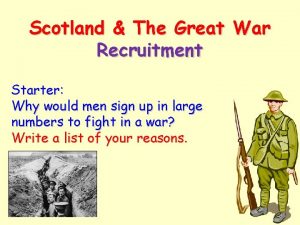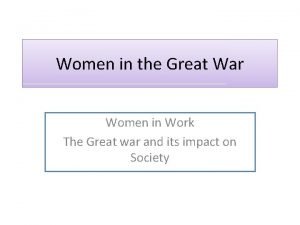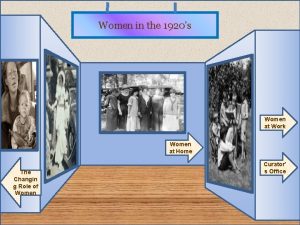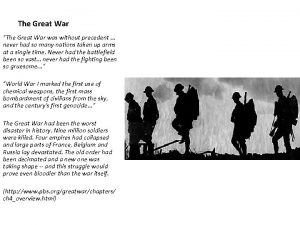Women in the Great War Women in Work















- Slides: 15

Women in the Great War Women in Work The Great war and its impact on Society

Todays Lesson • You will understand more about gender equality in our society • You will be able to compare the equality with todays society with the gender equality of the 1900’s • You will be able to understand about the role of women in society before WW 1

Todays Society Discuss • Discussion and write down your ideas 1. Do you think there is gender equality in todays society? 2. You have any examples where equality exists or does not exist? • Write down and discuss all your ideas

Facts about women today • Women are outnumbered 5 to 1 by men in the cabinet only 16% of senior ministerial posts are held by women. • 22% of MPs in the House of Commons are women. • 20% of members of the House of Lords are women • Only 4 out of 23 members of the UK Cabinet are women. • Of the top 1000 companies in the USA, only 25 are run by women. • In the top ten paying jobs for women, females earn less than men; only one career -- speech pathology -- pays the same regardless of gender.

Facts about women today • The full time gender pay gap is 10% • Average part-time pay gap is 34. 5%. • For each year a mother is absent from the workplace her future wages will reduce by 5%. • Approx 70% of people in national minimum wage jobs are women. • 54% of women working part-time have been found to be ‘employed below their potential’, (2. 8 million women).

Summarise the points • In your own words summarise the role that women in the workforce have in todays environment – You should mention the wage gap- gender division and inequalities – Aim to write 3 -5 sentences about women in work today

Women in British Society 1900’s Discuss • Discuss and write down your ideas 1. What position do you think most women held in British society in the 1900’s? 2. What rights and responsibilities did most women have?

Marriage and Family • Family was important • Queen Victoria was seen as the perfect role model. • Marriage could enhance the status of all women. • Divorce had to be granted by an Act of Parliament. Easier for men than women. It was considered to be scandalous.

Middle and Upper Classes • The man was the head of the household • Woman did as they were told. • A woman’s aim was to find a decent husband, with a large income, and have children. • Unmarried (spinsters) women were seen as ‘failures’ to be ridiculed and pitied. • Women relied on men for their status.

Middle and Upper Classes • Women were educated and brought up to fit her ‘role’ in society and to be dutiful (to their husbands). • Women were to be gentle, ladylike and appear to be less intelligent than her husband. • Had to run an efficient house, have a large family, and be faithful.

Working class • Working class wanted to aspire to middle class ideals but were held back by: 1 - Poverty and poor housing. Led to a life of hard work and childbearing. 2 -Cruelty- men had a brutal attitude enhanced by overcrowding and alcohol. 3 -Lack of education and legal rights meant they couldn’t escape an unsatisfactory marriage.


Matchstick Girls • The match girls worked from 6. 30 am (or 8 am in winter) until 6 pm, with just two breaks, standing all the time. “A typical case”, wrote Besant, “is that of a girl of 16, a piece worker; she earns 4 s a week, and lives with a sister, employed by the same firm, who ‘earns good money, as much as 8 s or 9 s per week’. Out of the earnings 2 s is paid for the rent of one room; the child lives on only bread-and-butter and tea, alike for breakfast and dinner”. How useful is this source in telling us about working conditions of the poor at the turn of the century?

Where would women work? • Lower class women in Scotland – – – – domestic servants jobs in factories and workshops, farms fishing ports laundry work All these jobs were poorly paid Children would also contribute to the family’s income by working as soon as they were old enough, usually by 12 years old. • Middle Class Women – housewives and to spend their time looking after their house and children. – Unmarried or widowed middle class women would work in ‘respectable’ occupations such as governesses, teachers and nurses – *Upper class women did not work – they had wealthy husbands – they often volunteered with local charities or foundations**

Task • Complete the task sheets 1) Women and work 2) Women at Work Before 1914 • If you have finished both tasks • Write two paragraphs explaining the difference between women’s equality in todays society and society before 1914
 Why have there been no great women artist
Why have there been no great women artist War at home and abroad madison
War at home and abroad madison Korean war vietnam war venn diagram
Korean war vietnam war venn diagram The cold war lesson 1 the cold war begins
The cold war lesson 1 the cold war begins Truman vs eisenhower venn diagram
Truman vs eisenhower venn diagram Why was josette dugas for the war of 1812
Why was josette dugas for the war of 1812 Ich war, du warst
Ich war, du warst Tug of war or tug-of-war
Tug of war or tug-of-war Why was the civil war the first modern war
Why was the civil war the first modern war Past simple ge
Past simple ge Chapter 16 lesson 2 challenges to slavery
Chapter 16 lesson 2 challenges to slavery Proxy wars in the cold war
Proxy wars in the cold war Chapter 30 the war to end war
Chapter 30 the war to end war Chapter 30 the war to end war
Chapter 30 the war to end war The great heroes before the trojan war
The great heroes before the trojan war Why did so many scots volunteer to fight in ww1
Why did so many scots volunteer to fight in ww1





























